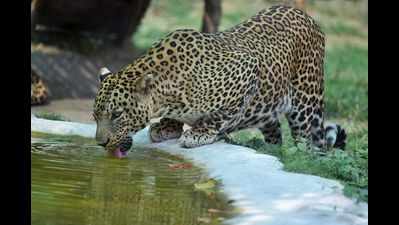- News
- City News
- gurgaon News
- Video: Aravalis in Gurugram, Faridabad core area for leopards, finds survey
Trending
This story is from June 19, 2017
Video: Aravalis in Gurugram, Faridabad core area for leopards, finds survey
In the first survey of its kind on population density of wild animals in five districts of Haryana, the Wildlife Institute of India (WII) has found leopards occupy a 200 square km area in these parts of the Aravalis. And the terrain in Gurgaon and Faridabad districts happens to be their core area.

GURUGRAM: In the first survey of its kind on population density of wild animals in five districts of Haryana, the Wildlife Institute of India (WII) has found leopards occupy a 200 square km area in these parts of the Aravalis. And the terrain in Gurgaon and Faridabad districts happens to be their core area.
“Total area under leopard occupancy was estimated to be 200.9 square kilometres.Sites namely Gamroj (Bhondsi), Raipur (Raisina), Mangar, Gothda, Badhkal, Kotla Kansali, Nimatpur (Nayaan), Khol and Panchota have higher psi (population stability index) estimates,” states the survey report, which was released by chief minister Manohar Lal Khattar and Union environment minister Harsh Vardhan on Saturday.
“Out of five districts — Gurgaon, Faridabad, Mewat, Rewari and Mahendergarh — the occupancy of leopards is the highest in Gurgaon and Faridabad. Moreover, the core zone (highest used region by the leopard) is also in these two districts,” said an official of WII who did not wish to be named.
Besides field sampling and analysis, WII used 12 camera traps to track the sightings of wild animals in the Aravalis. As many as seven sightings of leopards were reported in the camera traps within 30 days in October 2016. Moreover, sightings of 13 other species were recorded in the camera traps — seven of striped hyena, nine of golden jackal, 55 of nilgai, seven of palm civet, 14 of wild pig, 55 of rhesus macaque, 57 of peafowl and 12 of the Indian crested porcupine. The camera traps were put up in Bhondsi, Gamroj, Mangar, Bandhwari, Wazirabad, Gothda and Anangpur.
MD Sinha, conservator of forests (Gurgaon circle), said there has definitely been an increase in wildlife population, particularly that of leopards in the area. “There is an area of over 35,000 hectares around Gurgaon, which is very sensitive for wildlife. Seven sightings of big cats in 12 camera traps is a very good number,” he told TOI.
“Also, four successful leopard rescues have been conducted in the last six months by the forest department. There is an immediate need to protect the green cover and lay out a long-term wildlife management plan as wildlife is continuously increasing in the Aravalis,” he added.
Asked if a wildlife census will be conducted in the Aravalis, Sinha said, “The department has already submitted a plan to conduct a comprehensive study and census of wildlife. We have already submitted a proposal to put radio collars on wild animals.”
The WII report also recommended an immediate end to mining activities in Haryana.
“Total area under leopard occupancy was estimated to be 200.9 square kilometres.Sites namely Gamroj (Bhondsi), Raipur (Raisina), Mangar, Gothda, Badhkal, Kotla Kansali, Nimatpur (Nayaan), Khol and Panchota have higher psi (population stability index) estimates,” states the survey report, which was released by chief minister Manohar Lal Khattar and Union environment minister Harsh Vardhan on Saturday.
“Out of five districts — Gurgaon, Faridabad, Mewat, Rewari and Mahendergarh — the occupancy of leopards is the highest in Gurgaon and Faridabad. Moreover, the core zone (highest used region by the leopard) is also in these two districts,” said an official of WII who did not wish to be named.
Besides field sampling and analysis, WII used 12 camera traps to track the sightings of wild animals in the Aravalis. As many as seven sightings of leopards were reported in the camera traps within 30 days in October 2016. Moreover, sightings of 13 other species were recorded in the camera traps — seven of striped hyena, nine of golden jackal, 55 of nilgai, seven of palm civet, 14 of wild pig, 55 of rhesus macaque, 57 of peafowl and 12 of the Indian crested porcupine. The camera traps were put up in Bhondsi, Gamroj, Mangar, Bandhwari, Wazirabad, Gothda and Anangpur.
The survey found the jackal to be the highest-occurring carnivore species, followed by the hyena, and nilgai was found to be the highest occurring ungulate in the area. “Jackals are present in almost every grid with 92% occupancy,” the report states.
MD Sinha, conservator of forests (Gurgaon circle), said there has definitely been an increase in wildlife population, particularly that of leopards in the area. “There is an area of over 35,000 hectares around Gurgaon, which is very sensitive for wildlife. Seven sightings of big cats in 12 camera traps is a very good number,” he told TOI.
“Also, four successful leopard rescues have been conducted in the last six months by the forest department. There is an immediate need to protect the green cover and lay out a long-term wildlife management plan as wildlife is continuously increasing in the Aravalis,” he added.
Asked if a wildlife census will be conducted in the Aravalis, Sinha said, “The department has already submitted a plan to conduct a comprehensive study and census of wildlife. We have already submitted a proposal to put radio collars on wild animals.”
The WII report also recommended an immediate end to mining activities in Haryana.
End of Article
FOLLOW US ON SOCIAL MEDIA










